\(\hat{Q}=\text{30}\text{°}\); \(r=10\) and \(p=7\)
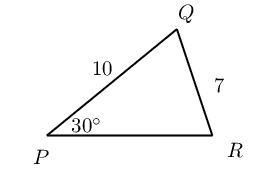
|
Previous
6.4 Trigonometric equations
|
Next
6.6 Summary
|
There are three identities relating to the trigonometric functions that make working with triangles easier:
the area rule
the sine rule
the cosine rule
Consider \(\triangle ABC\):
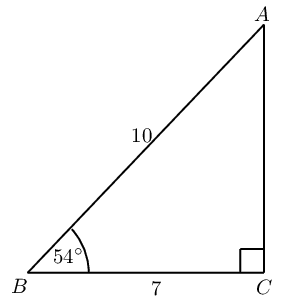
Complete the following:
Area \(\triangle ABC\) = \(\frac{1}{2} \times \ldots \times AC\)
\(\sin \hat{B} = \ldots\) and \(AC = \ldots \times \ldots\)
Therefore area \(\triangle ABC\) = \(\ldots \times \ldots \times \ldots \times \ldots\)
Consider \(\triangle A'B'C'\):
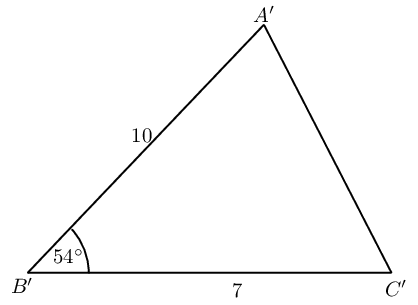
Complete the following:
How is \(\triangle A'B'C'\) different from \(\triangle ABC\)?
Calculate area \(\triangle A'B'C'\).
Use your results to write a general formula for determining the area of \(\triangle PQR\):
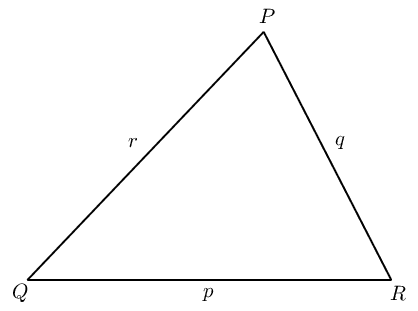
For any \(\triangle ABC\) with \(AB = c, BC = a\) and \(AC = b\), we can construct a perpendicular height (\(h\)) from vertex \(A\) to the line \(BC\):

In \(\triangle ABC\):
\begin{align*} \sin \hat{B}&= \frac{h}{c} \\ \therefore h &= c \sin \hat{B} \end{align*}And we know that
\begin{align*} \text{Area } \triangle ABC &= \frac{1}{2} \times a \times h \\ &= \frac{1}{2} \times a \times c \sin \hat{B} \\ \therefore \text{Area } \triangle ABC &= \frac{1}{2} ac \sin \hat{B} \end{align*}Alternatively, we could write that
\begin{align*} \sin \hat{C}&= \frac{h}{b} \\ \therefore h &= b \sin \hat{C} \end{align*}And then we would have that
\begin{align*} \text{Area } \triangle ABC &= \frac{1}{2} \times a \times h \\ &= \frac{1}{2} ab \sin \hat{C} \end{align*}Similarly, by constructing a perpendicular height from vertex \(B\) to the line \(AC\), we can also show that area \(\triangle ABC = \frac{1}{2} bc \sin \hat{A}\).
The area rule
In any \(\triangle ABC\):
\begin{align*} \text{Area } \triangle ABC &= \frac{1}{2} bc \sin \hat{A} \\ &= \frac{1}{2} ac \sin \hat{B} \\ &= \frac{1}{2} ab \sin \hat{C} \end{align*}Find the area of \(\triangle ABC\) (correct to two decimal places):
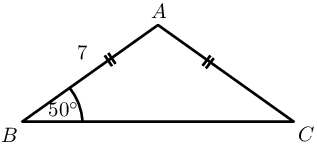
Notice that we do not know the length of side \(a\) and must therefore choose the form of the area rule that does not include this side of the triangle.
In \(\triangle ABC\):
\[\begin{array}{rll} \text{Area } &= \frac{1}{2} bc \sin \hat{A} & \\ &= \frac{1}{2} (7)(7) \sin \text{80}\text{°} & \\ &= \text{24,13} & \end{array}\]Area of \(\triangle ABC = \text{24,13}\) square units.
Show that the area of \(\triangle DEF = \frac{1}{2} df \sin \hat{E}\).
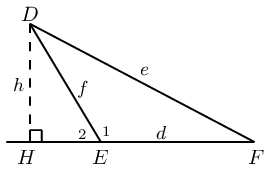
Draw \(DH\) such that \(DH \perp EF\) and let \(DH = h\), \(D\hat{E}F = \hat{E}_1\) and \(D\hat{E}H = \hat{E}_2\).
In \(\triangle DHE\):
\[\begin{array}{rll} \sin \hat{E}_2 &= \dfrac{h}{f} & \\ h &= f \sin (\text{180}\text{°} - \hat{E}_1) & (\angle \text{s on str. line})\\ &= f \sin \hat{E}_1 & \end{array}\]In \(\triangle DEF\):
\begin{align*} \text{Area } &= \frac{1}{2} d \times h \\ &= \frac{1}{2} df \sin \hat{E}_1 \end{align*}The area rule
In any \(\triangle PQR\):
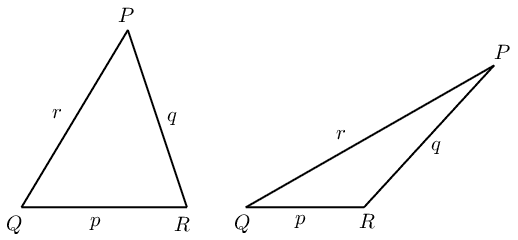
The area rule states that the area of any triangle is equal to half the product of the lengths of the two sides of the triangle multiplied by the sine of the angle included by the two sides.
Draw a sketch and calculate the area of \(\triangle PQR\) given:
\(\hat{Q}=\text{30}\text{°}\); \(r=10\) and \(p=7\)

\(\hat{R}=\text{110}\text{°}\); \(p=8\) and \(q=9\)
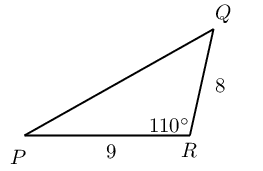
Find the area of \(\triangle XYZ\) given \(XZ = \text{52}\text{ cm}\), \(XY = \text{29}\text{ cm}\) and \(\hat{X} = \text{58,9}\text{°}\).
Determine the area of a parallelogram in which two adjacent sides are \(\text{10}\) \(\text{cm}\) and \(\text{13}\) \(\text{cm}\) and the angle between them is \(\text{55}\)\(\text{°}\).
If the area of \(\triangle ABC\) is \(\text{5 000}\) \(\text{m$^{2}$}\) with \(a=\text{150}\text{ m}\) and \(b=\text{70}\text{ m}\), what are the two possible sizes of \(\hat{C}\)?
So far we have only applied the trigonometric ratios to right-angled triangles. We now expand the application of the trigonometric ratios to triangles that do not have a right angle:
In \(\triangle ABC\), \(AC = 15\), \(BC = 11\) and \(\hat{A} = \text{48}\text{°}\). Find \(\hat{B}\).
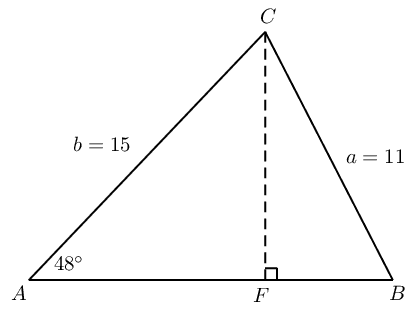
Method \(\text{1}\): using the sine ratio
Draw a sketch of \(\triangle ABC\).
Construct \(CF \perp AB\).
In \(\triangle CBF\):
\begin{align*} \frac{CF}{\ldots} &= \sin \hat{B} \\ \therefore CF &= \ldots \times \sin \hat{B} \end{align*}In \(\triangle CAF\):
\begin{align*} \frac{CF}{15} &= \ldots \\ \therefore CF &= 15 \times \ldots \end{align*}Therefore we have that:
\begin{align*} CF &= 15 \times \ldots \\ \text{and } CF &= \ldots \times \sin \hat{B} \\ \therefore 15 \times \ldots &= \ldots \times \sin \hat{B} \\ \therefore \sin \hat{B} &= \ldots \ldots \ldots \\ \therefore \hat{B} &= \ldots \end{align*}Method \(\text{2}\): using the area rule
In \(\triangle ABC\):
\begin{align*} \text{Area } \triangle ABC &= \frac{1}{2} AB \times AC \times \ldots \\ &= \frac{1}{2} AB \times \ldots \times \ldots \end{align*}And we also know that
\[\text{Area } \triangle ABC = \frac{1}{2} AB \times \ldots \times \sin \hat{B}\]We can equate these two equations and solve for \(\hat{B}\): \begin{align*} \frac{1}{2} AB \times \ldots \times \sin \hat{B} &= \frac{1}{2} AB \times \ldots \times \ldots \\ \therefore \ldots \times \sin \hat{B} &= \ldots \times \ldots \\ \therefore \sin \hat{B} &= \ldots \times \ldots \\ \therefore \hat{B} &= \ldots \end{align*}
Use your results to write a general formula for the sine rule given \(\triangle PQR\):
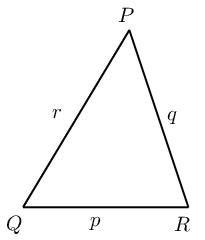
For any triangle \(ABC\) with \(AB = c, BC = a\) and \(AC = b\), we can construct a perpendicular height (\(h\)) at \(F\):
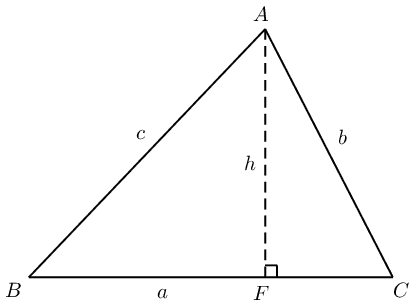
Method \(\text{1}\): using the sine ratio
In \(\triangle ABF\):
\begin{align*} \sin \hat{B}&= \frac{h}{c} \\ \therefore h &= c \sin \hat{B} \end{align*}In \(\triangle ACF\):
\begin{align*} \sin \hat{C}&= \frac{h}{b} \\ \therefore h &= b \sin \hat{C} \end{align*}We can equate the two equations
\begin{align*} c \sin \hat{B}&= b \sin \hat{C} \\ \therefore \frac{\sin \hat{B}}{b} &= \frac{\sin \hat{C}}{c} \\ \text{or } \frac{b}{\sin \hat{B}} &= \frac{c}{\sin \hat{C}} \end{align*}Similarly, by constructing a perpendicular height from vertex \(B\) to the line \(AC\), we can also show that:
\begin{align*} \frac{\sin \hat{A}}{a} &= \frac{\sin \hat{C}}{c} \\ \text{or } \frac{a}{\sin \hat{A}} &= \frac{c}{\sin \hat{C}} \end{align*}Similarly, by constructing a perpendicular height from vertex \(B\) to the line \(AC\), we can also show that area \(\triangle ABC = \frac{1}{2} bc \sin \hat{A}\).
Method \(\text{2}\): using the area rule
In \(\triangle ABC\):
\begin{align*} \text{Area } \triangle ABC &= \frac{1}{2} ac \sin \hat{B} \\ &= \frac{1}{2} ab \sin \hat{C} \\ \therefore \frac{1}{2} ac \sin \hat{B} &= \frac{1}{2} ab \sin \hat{C} \\ c \sin \hat{B} &= b \sin \hat{C} \\ \frac{\sin \hat{B}}{b} &= \frac{\sin \hat{C}}{c} \\ \text{or } \frac{b}{\sin \hat{B}} &= \frac{c}{\sin \hat{C}} \end{align*}The sine rule
In any \(\triangle ABC\):
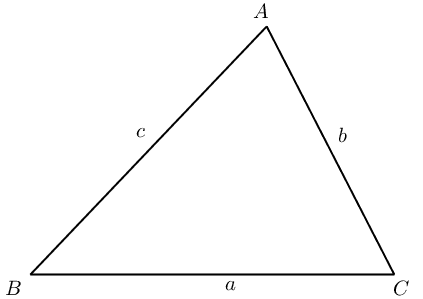
Given \(\triangle TRS\) with \(S\hat{T}R = \text{55}\text{°}\), \(TR = 30\) and \(R\hat{S}T = \text{40}\text{°}\), determine \(RS, ST\) and \(T\hat{R}S\).
Let \(RS = t\), \(ST = r\) and \(TR = s\).
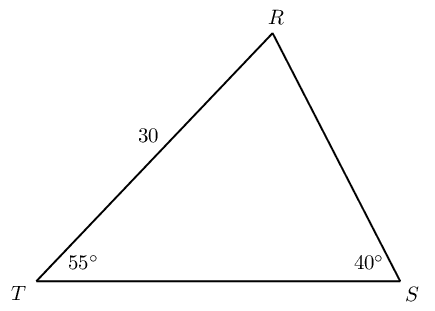
Prove the sine rule for \(\triangle MNP\) with \(MS \perp NP\).
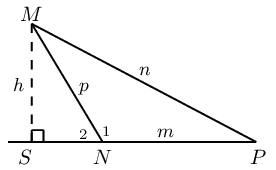
In \(\triangle MSN\):
\[\begin{array}{rll} \sin \hat{N}_2&= \frac{h}{p} & \\ \therefore h &= p \sin \hat{N}_2 & \\ \text{and } \hat{N}_2 &= \text{180}\text{°}- \hat{N}_1 & \angle \text{s on str. line} \\ \therefore h &= p \sin (\text{180}\text{°}- \hat{N}_1) & \\ &= p \sin \hat{N}_1 \end{array}\]In \(\triangle MSP\):
\begin{align*} \sin \hat{P}&= \frac{h}{n} \\ \therefore h &= n \sin \hat{P} \end{align*}The ambiguous case
If two sides and an interior angle of a triangle are given, and the side opposite the given angle is the shorter of the two sides, then we can draw two different triangles (\(\triangle NMP\) and \(\triangle NMP'\)), both having the given dimensions. We call this the ambiguous case because there are two ways of interpreting the given information and it is not certain which is the required solution.
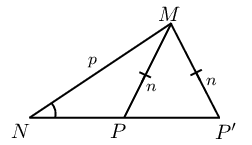
In \(\triangle ABC\), \(AB = 82\), \(BC = 65\) and \(\hat{A} = \text{50}\text{°}\). Draw \(\triangle ABC\) and find \(\hat{C}\) (correct to one decimal place).
We notice that for the given dimensions of \(\triangle ABC\), the side \(BC\) opposite \(\hat{A}\) is shorter than \(AB\). This means that we can draw two different triangles with the given dimensions.
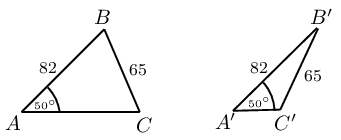
In \(\triangle ABC\):
\begin{align*} \frac{\sin \hat{A}}{BC} &= \frac{\sin \hat{C}}{AB} \\ \frac{\sin \text{50}\text{°}}{65} &= \frac{\sin \hat{C}}{82} \\ \therefore \frac{\sin \text{50}\text{°}}{65} \times 82 &= \sin \hat{C} \\ \therefore \hat{C} &= \text{75,1}\text{°} \end{align*}In \(\triangle A'B'C'\):
We know that \(\sin (\text{180} - \hat{C}) = \sin \hat{C}\), which means we can also have the solution
\begin{align*} \hat{C'}&= \text{180}\text{°} - \text{75,1}\text{°} \\ &= \text{104,9}\text{°} \end{align*}Both solutions are correct.
There is a coastline with two lighthouses, one on either side of a beach. The two lighthouses are \(\text{0,67}\) \(\text{km}\) apart and one is exactly due east of the other. The lighthouses tell how close a boat is by taking bearings to the boat (a bearing is an angle measured clockwise from north). These bearings are shown on the diagram below.
Calculate how far the boat is from each lighthouse.
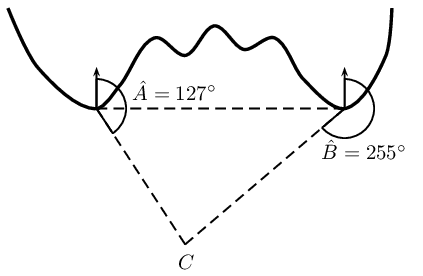
We see that the two lighthouses and the boat form a triangle. Since we know the distance between the lighthouses and we have two angles we can use trigonometry to find the remaining two sides of the triangle, the distance of the boat from the two lighthouses.
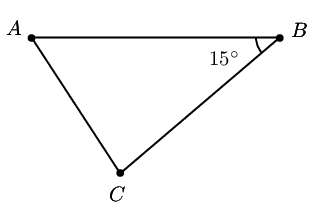
We need to determine the lengths of the two sides \(AC\) and \(BC\). We can use the sine rule to find the missing lengths.
\begin{align*} \frac{BC}{\sin\hat{A}} &= \frac{AB}{\sin\hat{C}} \\ BC &= \frac{AB \cdot \sin\hat{A}}{\sin\hat{C}} \\ &= \frac{(\text{0,67}\text{ km})\sin \text{37}\text{°}}{\sin \text{128}\text{°}} \\ &= \text{0,51}\text{ km} \end{align*}\begin{align*} \frac{AC}{\sin\hat{B}} &= \frac{AB}{\sin\hat{C}} \\ AC &= \frac{AB \cdot \sin\hat{B}}{\sin\hat{C}} \\ &= \frac{(\text{0,67}\text{ km})\sin \text{15}\text{°}}{\sin \text{128}\text{°}} \\ &= \text{0,22}\text{ km} \end{align*}Find all the unknown sides and angles of the following triangles:
\(\triangle PQR\) in which \(\hat{Q}=\text{64}\text{°}\); \(\hat{R}=\text{24}\text{°}\) and \(r=3\)
\(\triangle KLM\) in which \(\hat{K}=\text{43}\text{°}\); \(\hat{M}=\text{50}\text{°}\) and \(m=1\)
\(\triangle ABC\) in which \(\hat{A} = \text{32,7}\text{°}\); \(\hat{C} = \text{70,5}\text{°}\) and \(a = \text{52,3}\)
\(\triangle XYZ\) in which \(\hat{X}=\text{56}\text{°}\); \(\hat{Z}=\text{40}\text{°}\) and \(x=50\)
In \(\triangle ABC\), \(\hat{A}=\text{116}\text{°}\); \(\hat{C}=\text{32}\text{°}\) and \(AC = \text{23}\text{ m}\). Find the lengths of the sides \(AB\) and \(BC\).
In \(\triangle RST\), \(\hat{R}=\text{19}\text{°}\); \(\hat{S}=\text{30}\text{°}\) and \(RT = \text{120}\text{ km}\). Find the length of the side \(ST\).
In \(\triangle KMS\), \(\hat{K}=\text{20}\text{°}\); \(\hat{M}=\text{100}\text{°}\) and \(s = \text{23}\text{ cm}\). Find the length of the side \(m\).
In \(\triangle ABD\), \(\hat{B} = \text{90}\text{°}\), \(AB = \text{10}\text{ cm}\) and \(A\hat{D}B = \text{40}\text{°}\). In \(\triangle BCD\), \(\hat{C} = \text{106}\text{°}\) and \(C\hat{D}B = \text{15}\text{°}\). Determine \(BC\).
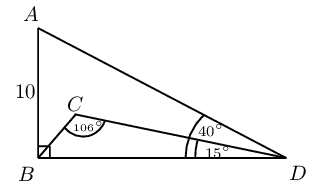
In \(\triangle ABC\), \(\hat{A} = \text{33}\text{°}\), \(AC = \text{21}\text{ mm}\) and \(AB = \text{17}\text{ mm}\). Can you determine \(BC\)?
No, not enough information is given
If a triangle is given with two sides and the included angle known, then we can not solve for the remaining unknown sides and angles using the sine rule. We therefore investigate the cosine rule:
In \(\triangle ABC, AB = 21, AC = 17\) and \(\hat{A} = \text{33}\text{°}\). Find \(\hat{B}\).
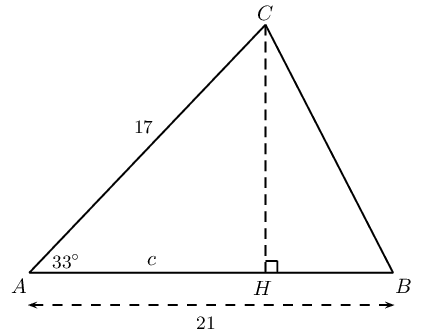
Determine \(CB\):
Construct \(CH \perp AB\).
Let \(AH = c\) and therefore \(HB = \ldots\)
Applying the theorem of Pythagoras in the right-angled triangles:
In\(\triangle CHB\):
\begin{align*} CB^2 &= BH^2 + CH^2 \\ &= (\ldots)^2 + CH^2 \\ &= 21^2 -(2)(21)c + c^2 + CH^2 \ldots \ldots (1) \end{align*}In \(\triangle CHA\):
\begin{align*} CA^2 &= c^2 + CH^2 \\ 17^2 &= c^2 + CH^2 \ldots \ldots (2) \end{align*}Substitute equation \((2)\) into equation \((1)\):
\[CB^2 = 21^2 -(2)(21)c + 17^2\]Now \(c\) is the only remaining unknown. In \(\triangle CHA\):
\begin{align*} \frac{c}{17} &= \cos \text{33}\text{°} \\ \therefore c &= 17 \cos \text{33}\text{°} \end{align*}Therefore we have that
\begin{align*} CB^2 &= 21^2 -(2)(21)c + 17^2 \\ &= 21^2 -(2)(21)(17 \cos \text{33}\text{°}) + 17^2 \\ &= 21^2 + 17^2 -(2)(21)(17) \cos \text{33}\text{°} \\ &= \text{131,189}\ldots \\ \therefore CB &= \text{11,5} \end{align*}Use your results to write a general formula for the cosine rule given \(\triangle PQR\):
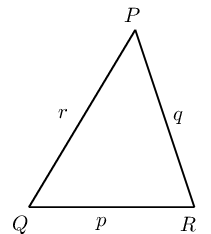
The cosine rule relates the length of a side of a triangle to the angle opposite it and the lengths of the other two sides.
Consider \(\triangle ABC\) with \(CD \perp AB\):
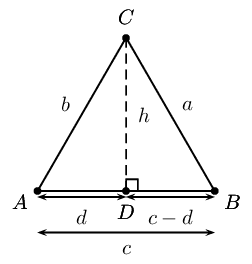
In \(\triangle DCB\): \(a^2 = (c-d)^2 + h^2\) from the theorem of Pythagoras.
In \(\triangle ACD\): \(b^2 = d^2 + h^2\) from the theorem of Pythagoras.
Since \(h^2\) is common to both equations we can write: \begin{align*} a^2 &= (c-d)^2 + h^2 \\ \therefore h^2 &= a^2 - (c-d)^2 \\ \text{And } b^2 &= d^2 + h^2 \\ \therefore h^2 &= b^2 - d^2 \\ \therefore b^2 - d^2 &= a^2 - (c-d)^2 \\ a^2 &= b^2 + (c^2 - 2cd + d^2) - d^2 \\ &= b^2 + c^2 - 2cd \end{align*}
In order to eliminate \(d\) we look at \(\triangle ACD\), where we have: \(\cos\hat{A} = \frac{d}{b}\). So, \(d = b \cos \hat{A}\).
Substituting back we get: \({a}^{2}={b}^{2}+{c}^{2}-2bc \cos \hat{A}\).
The cosine rule
In any \(\triangle ABC\):
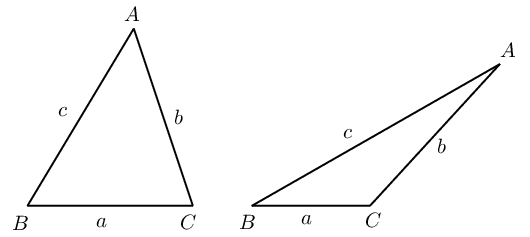
Determine the length of \(QR\).
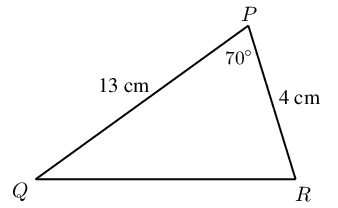
\(QR = \text{12,2}\text{ cm}\)
Determine \(\hat{A}\).
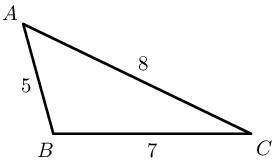
Applying the cosine rule:
\begin{align*} {a}^{2} &= {b}^{2}+{c}^{2}-2bc \cos \hat{A} \\ \therefore \cos\hat{A} &= \frac{{b}^{2}+{c}^{2}-{a}^{2}}{2bc} \\ &= \frac{{8}^{2}+{5}^{2}-{7}^{2}}{2 \cdot 8 \cdot 5} \\ &= \text{0,5} \\ \therefore \hat{A} &= \text{60}\text{°} \end{align*}It is very important:
How to determine which rule to use:
Area rule:
Sine rule:
Cosine rule:
Solve the following triangles (that is, find all unknown sides and angles):
\(\triangle ABC\) in which \(\hat{A}=\text{70}\text{°}\); \(b=4\) and \(c=9\)
\(\triangle RST\) in which \(RS=14\); \(ST=26\) and \(RT=16\)
\(\triangle KLM\) in which \(KL=5\); \(LM=10\) and \(KM=7\)
\(\triangle JHK\) in which \(\hat{H}=\text{130}\text{°}\); \(JH=13\) and \(HK=8\)
\(\triangle DEF\) in which \(d=4\); \(e=5\) and \(f=7\)
Find the length of the third side of the \(\triangle XYZ\) where:
\(\hat{X} = \text{71,4}\text{°}\); \(y = \text{3,42}\text{ km}\) and \(z = \text{4,03}\text{ km}\)
\(x = \text{103,2}\text{ cm}\); \(\hat{Y} = \text{20,8}\text{°}\) and \(z = \text{44,59}\text{ cm}\)
Determine the largest angle in:
\(\triangle JHK\) in which \(JH=6\); \(HK=4\) and \(JK=3\)
\(\triangle PQR\) where \(p=50\); \(q=70\) and \(r=60\)
\(Q\) is a ship at a point \(\text{10}\) \(\text{km}\) due south of another ship \(P\). \(R\) is a lighthouse on the coast such that \(\hat{P} = \hat{Q} = \text{50}\text{°}\).
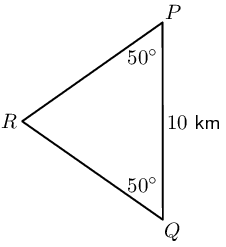
Determine:
the distance \(QR\)
the shortest distance from the lighthouse to the line joining the two ships (\(PQ\)).
\(WXYZ\) is a trapezium, \(WX\parallel YZ\) with \(WX = \text{3}\text{ m}\); \(YZ = \text{1,5}\text{ m}\); \(\hat{Z}=\text{120}\text{°}\) and \(\hat{W}=\text{30}\text{°}\).
Determine the distances \(XZ\) and \(XY\).
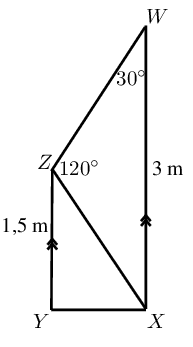
On a flight from Johannesburg to Cape Town, the pilot discovers that he has been flying \(\text{3}\)\(\text{°}\) off course. At this point the plane is \(\text{500}\) \(\text{km}\) from Johannesburg. The direct distance between Cape Town and Johannesburg airports is \(\text{1 552}\) \(\text{km}\). Determine, to the nearest \(\text{km}\):
The distance the plane has to travel to get to Cape Town and hence the extra distance that the plane has had to travel due to the pilot's error.
The correction, to one hundredth of a degree, to the plane's heading (or direction).
\(ABCD\) is a trapezium (meaning that \(AB\parallel CD\)). \(AB=x\); \(B\hat{A}D=a\); \(B\hat{C}D=b\) and \(B\hat{D}C=c\).
Find an expression for the length of \(CD\) in terms of \(x\), \(a\), \(b\) and \(c\).
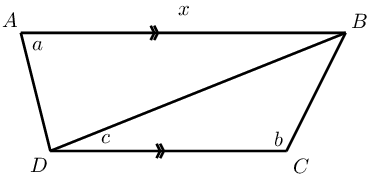
A surveyor is trying to determine the distance between points \(X\) and \(Z\). However the distance cannot be determined directly as a ridge lies between the two points. From a point \(Y\) which is equidistant from \(X\) and \(Z\), he measures the angle \(X\hat{Y}Z\).
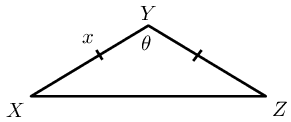
If \(XY=x\) and \(X\hat{Y}Z=\theta\), show that \(XZ = x\sqrt{2(1- \cos \theta)}\).
Calculate \(XZ\) (to the nearest kilometre) if \(x=\text{240}\) km and \(\theta = \text{132}\text{°}\).
Find the area of \(WXYZ\) (to two decimal places):
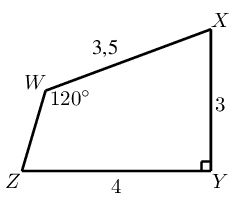
Find the area of the shaded triangle in terms of \(x\), \(\alpha\), \(\beta\), \(\theta\) and \(\phi\):
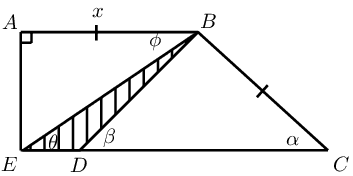
|
Previous
6.4 Trigonometric equations
|
Table of Contents |
Next
6.6 Summary
|